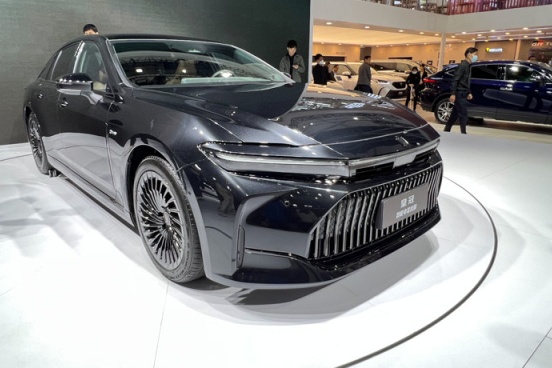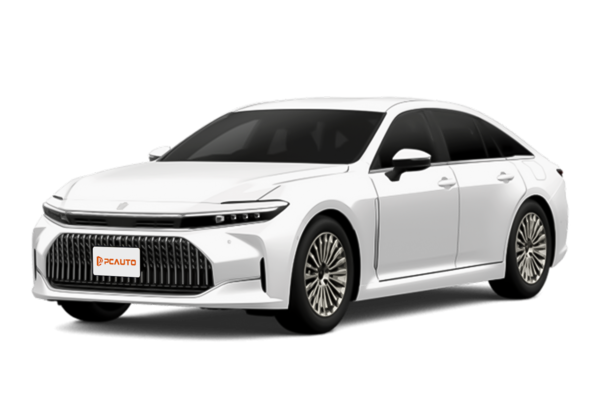Q
How does the 2024 Crown compare to the Avalon?
The 2024 Toyota Crown gets significant upgrades in design, powertrain, and tech features compared to the Avalon. The Crown goes for a more cutting-edge crossover vibe, offering standard hybrid and plug-in hybrid options, while the Avalon, as a traditional sedan, focuses more on comfort and space. The Crown comes standard with a 12.3-inch infotainment screen and Toyota's latest TSS 3.0 safety suite, giving it a stronger tech feel. The Avalon, on the other hand, sticks with a more classic layout, better suited for drivers who prefer that traditional ride experience. Under the hood, the Crown's hybrid system delivers better fuel efficiency, making it ideal for city commuting, while the Avalon's 3.5L V6 cranks out more robust power. Both cars have comfort-focused suspension setups, but the Crown sits higher off the ground for better rough-road capability. For shoppers looking to switch rides, the Crown is the way to go if you want sleek design and advanced tech. If you're more about that classic sedan feel and big-displacement power, the Avalon still has its appeal. It's worth noting that with the shift toward electrification, hybrid and plug-in hybrid models are only going to get more advantages in daily running costs and eco-friendliness.
Special Disclaimer: This content is published by users and does not represent the views or position of PCauto.
Related Q&A
Q
How much horsepower does the 2024 Crown have?
The 2024 Toyota Crown offers different horsepower outputs based on powertrain configurations. The hybrid version pairs a 2.5-liter four-cylinder engine with an electric motor, delivering a combined 236 horsepower, while the more powerful 2.4-liter turbocharged hybrid system cranks out a maximum 340 horsepower. Both setups prioritize a balance of efficiency and eco-friendliness. As Toyota's flagship model, the Crown features advanced hybrid technology that not only boosts fuel economy but also enhances the driving experience, making it suitable for daily commutes and long road trips. What's more, the hybrid battery pack is specifically positioned to avoid eating into cabin space while ensuring smooth acceleration. For buyers who care about performance, the turbocharged variant delivers stronger acceleration, while the standard hybrid caters better to those chasing efficiency. Toyota's ongoing innovations in hybrid tech have allowed the Crown to stand out in balancing performance and green credentials, making it a solid competitor in its class.
Q
How much does a 2024 Toyota Crown cost?
The 2024 Toyota Crown is expected to be priced locally between RM250,000 and RM350,000, with specific prices varying by trim level. The entry-level hybrid variant will likely start around RM250,000, while the range-topping sports model or four-wheel drive high-spec version could approach RM350,000. Built on Toyota's latest TNGA-K platform, this car offers two powertrain options: a 2.5-liter hybrid system and a 2.4-liter turbocharged engine, both paired with the Direct Shift-8AT transmission for a good balance of fuel efficiency and performance. As Toyota's flagship sedan, the Crown comes standard with premium features like a 12.3-inch touchscreen, TSS 3.0 safety suite, and panoramic sunroof. Its dimensions fall between the Camry and Lexus ES, with a 2,850mm wheelbase providing ample rear legroom. Notably, it adopts a crossover design with slightly higher ground clearance than traditional sedans and offers an optional E-Four Advanced electronic all-wheel drive system, making it ideal for buyers seeking refined driving dynamics with added versatility. When purchasing, keep an eye out for official promotions—some dealers may offer complimentary maintenance packages or low-interest financing deals.
Q
How fast is the Toyota Crown 2024 0 to 60?
The 2024 Toyota Crown clocks in at around 5.7 seconds for the 0-60 mph (approximately 96 km/h) sprint, a performance largely thanks to its hybrid system's robust power delivery. The high-end trim, in particular, packs a 2.4-liter turbocharged hybrid engine that cranks out a combined 340 horsepower, striking a nice balance between performance and fuel efficiency. As Toyota's premium offering, the Crown stands out in its class of hybrid sedans when it comes to acceleration, making it a solid pick for buyers who want both power and eco-friendliness. Beyond straight-line speed, this car comes loaded with advanced driver-assistance features and a plush interior—think a 12.3-inch touchscreen and a fully digital gauge cluster—that up the tech and comfort ante. It's worth mentioning that the hybrid system's instant torque makes for quick getaways, while the electronic all-wheel-drive system sharpens grip, especially keeping things steady on wet roads. If you're craving more thrills, check out its Sport mode tuning, which dials up the driving experience for a more aggressive feel.
Q
How much is the 2024 Crown XLE?
The official price of the 2024 Toyota Crown XLE currently ranges from approximately RM250,000 to RM300,000, with the exact figure potentially varying based on optional configurations, dealer discounts, or promotional activities. This model is equipped with a 2.5-liter hybrid system that delivers a combined 234 horsepower, paired with an electronic all-wheel-drive system. It achieves a fuel consumption of around 5.6L/100km, balancing performance and fuel efficiency nicely. Standard features include a 12.3-inch infotainment screen, Toyota Safety Sense 3.0, a panoramic sunroof, and leather seats, among other premium touches. Notably, as Toyota's flagship sedan, the 2024 Crown rides on the new TNGA-K platform, which enhances body rigidity while lowering the center of gravity, resulting in noticeably improved handling stability compared to its predecessor. When considering competitors in the same class, you might compare it to hybrid versions of the Honda Accord or Nissan Teana, but the Crown XLE holds an edge in terms of sound insulation and rear passenger space. It's advisable to visit an authorized dealership for a test drive before purchasing to experience the suspension tuning and the hybrid system's smoothness firsthand, and keep an eye out for possible special offers during year-end auto shows.
Q
Is the Toyota Crown 2024 electric or gas?
The 2024 Toyota Crown currently offers a variety of powertrain options, including traditional gasoline versions and hybrid versions, but there's no pure electric variant available yet. The gasoline models come with either a 2.5-liter four-cylinder engine or a 3.5-liter V6, while the hybrid pairs a 2.5-liter engine with an electric motor, balancing fuel efficiency and performance. Design-wise, this car blends elements of a sporty coupe and a luxury sedan, packing advanced driver assistance systems and tech features like a full digital instrument cluster and a large infotainment screen. Even though there's no pure EV option right now, Toyota is ramping up its electrification efforts globally, so we might see more new energy models down the line. For eco-conscious buyers, the hybrid is a solid pick—it delivers better overall fuel economy than traditional gas-powered cars, and you don't have to stress about charging infrastructure. The Crown lineup has always been known for comfort and reliability, and the 2024 model carries on that tradition while stepping up interior quality and sound insulation. If you're set on a pure electric vehicle, keep an eye on Toyota's bZ series or check out EVs from other brands—there are already plenty of choices in the local market.
Q
Where is the 2024 Toyota Crown made?
The 2024 Toyota Crown is primarily built at Toyota's Motomachi Plant in Japan, a facility renowned for crafting premium models and prioritizing craftsmanship. This car rides on Toyota's latest TNGA-K platform, striking a balance between handling stability and ride comfort. Under the hood, you've got two choices: a 2.5-liter hybrid and a 2.4-liter turbocharged hybrid. The latter comes with the DIRECT4 electronic all-wheel-drive system, which smartly distributes torque to enhance cornering performance. It's worth noting that as Toyota's flagship model, the Crown's hybrid system has been specially tuned to deliver more immediate power response while keeping fuel consumption low. Local buyers might notice it leans more into sporty styling than traditional Toyotas, with things like the sloping roofline and 21-inch wheels, yet the interior remains spacious, with rear legroom that's top-notch for its class. On the after-sales front, Toyota offers an 8-year/200,000-kilometer warranty for the hybrid battery and a 5-year/100,000-kilometer warranty for the powertrain, so you can drive with peace of mind. Even though it's positioned as a premium offering, maintenance costs aren't drastically different from regular Toyotas, with routine service recommended every 10,000 kilometers or 6 months.
Q
How much does a 2024 Toyota Crown Platinum cost?
The 2024 Toyota Crown Platinum, as the flagship model, is expected to be priced between RM 350,000 and RM 400,000, depending on optional configurations and dealer promotions. It's powered by a 2.4-liter turbocharged hybrid system with a combined output of 340 horsepower, paired with an electronic all-wheel-drive system, delivering impressive performance and fuel efficiency. Inside, you'll find premium leather seats, a 12.3-inch digital instrument cluster, and a head-up display, packing plenty of tech appeal. On the safety front, it comes standard with Toyota Safety Sense 3.0, which includes pre-collision warning and full-speed adaptive cruise control. Positioned between luxury and sportiness, the Crown Platinum prioritizes comfort more than its German rivals in the same price bracket, while offering better value for money compared to Lexus models. Recent fluctuations in the Japanese yen exchange rate might affect the final selling price, so it's advisable to compare packages from different dealers before making a purchase—some dealerships may even offer perks like free maintenance or low-interest financing.
Q
What is the difference between 2024 and 2025 Toyota Crown?
The main differences between the 2024 and 2025 Toyota Crown lie in exterior details, equipment upgrades, and powertrain refinements. The 2025 model likely gets sharper lines and updated LED lighting up front, while interior materials and tech get a boost too—think a bigger infotainment screen or the latest multimedia system. Under the hood, the 2025 Crown probably sees improved hybrid efficiency for better fuel economy, and some markets might even get new powertrain options. For fans of the model, the 2025 updates are more about tweaking details and enhancing the user experience rather than a full redesign. So if you're watching your budget, the 2024 version still holds up as a solid pick. With its long history, the Toyota Crown has always been known for comfort and reliability, and the new model keeps that tradition alive—perfect for buyers who value quality and practicality.
Q
How much is a 2024 Toyota Crown worth?
The 2024 Toyota Crown is expected to be priced locally between RM250,000 and RM350,000, depending on the trim level and optional features. For instance, the base model comes with a 2.5-liter hybrid system, while higher-end variants might feature a more powerful 3.5-liter V6 engine or an electronic all-wheel-drive system. Positioned as a luxury sports sedan, it rides on Toyota's latest TNGA-K platform, balancing a low center of gravity with comfort. It also comes standard with the TSS 3.0 safety suite, including pre-collision warning and lane-keeping assist. Notably, as Toyota's flagship model, the hybrid version stands out for fuel efficiency, with a combined consumption as low as around 5 liters per 100 kilometers – ideal for consumers who value technology and energy efficiency. Additionally, the new vehicle typically comes with a 5-year warranty, and the hybrid battery gets an extra 8-year coverage, offering relatively comprehensive after-sales service. If considering the used car market, prioritize factory-certified vehicles to ensure quality. Also, keep in mind that the 2024 model, being newly launched, will have a higher depreciation rate, so it's advisable to compare prices across different channels.
Q
How does the 2024 Crown compare to Camry?
Although both the 2024 Toyota Crown and Camry are midsize sedans under the Toyota brand, their positioning and technical differences are significant. The Crown rides on Toyota's latest TNGA-K platform, offering hybrid and plug-in hybrid options, with a focus on luxury and technology. Its interior uses higher-grade materials, comes standard with a 12.3-inch touchscreen and digital instrument cluster, and has a larger body with a 2850mm wheelbase, providing more spacious rear seating. The Camry, on the other hand, leans toward practicality and fuel efficiency, featuring a standard 8-inch infotainment screen and an excellent fuel-efficient hybrid version, making it ideal for daily family use. In terms of performance, the high-end Crown is equipped with a 2.4T turbocharged hybrid system delivering a combined 340 horsepower, while the Camry highlights a 2.5L naturally aspirated hybrid, excelling in smoothness and reliability. Both models come standard with Toyota's TSS 3.0 safety system, but the Crown adds premium features like automatic parking and panoramic imaging. If you're after a luxurious experience and stronger power, the Crown is the better pick, while the Camry is more suitable if you prioritize value for money and low fuel consumption. Toyota has made significant strides in hybrid technology in recent years; both vehicles offer much improved battery life and energy efficiency compared to earlier models, with relatively reasonable maintenance costs.
Latest Q&A
Q
Is 2019 a good year for Hyundai Santa Fe?
The 2019 Hyundai Santa Fe is a well-rounded midsize SUV that’s great for families, with notable improvements in safety and comfort. This generation features Hyundai’s latest design language, giving it a sharper look, while the interior gets upgraded materials and craftsmanship. The 2.4L and 2.0T engines deliver smooth power, and fuel efficiency is above average for its class.
It also comes packed with advanced safety tech like forward collision warning, lane-keeping assist, and adaptive cruise control—features that were quite competitive at the time. If you’re looking at the used market, the 2019 Santa Fe offers solid value, though it’s always smart to check the maintenance history and overall condition before buying.
For shoppers who prioritize comfort and tech, this SUV is worth considering, especially thanks to its spacious cabin and practicality for everyday family needs.
Q
What recalls are on the 2019 Hyundai Santa Fe?
The 2019 Hyundai Santa Fe faced global recalls due to several safety concerns, primarily involving two critical issues. First, the anti-lock braking system (ABS) module could experience electrical shorts from a software glitch, increasing engine compartment fire risks—resolved through a control module software update. Second, the second-row seatbelt pretensioners might detach during collisions, compromising occupant restraint, requiring replacement with reinforced parts. Some vehicles also had poorly welded wiper linkage assemblies that could fail, prompting dealership inspections and part swaps if defective.
These recalls are typically handled free of charge at local dealerships—owners can check their VIN status via Hyundai’s official website. Notably, Hyundai’s recall system reflects its proactive stance on safety, with regular software patches and hardware checks now routine for owners. For parallel imports, contacting authorized service centers is advised, as certain region-specific recalls may require special handling. Staying in touch with dealers and completing recall repairs promptly ensures vehicles meet original safety standards.
Q
Does the 2019 Hyundai Santa Fe have transmission problems?
The 8-speed automatic transmission in the 2019 Hyundai Santa Fe delivers solid performance overall, though some owners have reported occasional mild jerking during low-speed gear changes. These hiccups typically stem from software calibration rather than mechanical issues – your dealer can usually smooth them out with a complimentary TCU reprogramming.
Sharing its core architecture with the Kia Sorento's gearbox, this transmission has been torture-tested in high-humidity conditions to handle local weather. Stick to the factory-recommended SP-IV fluid changes every 60,000 km – it's the single biggest factor in keeping this transmission alive. If you notice delayed shifts or odd noises, always check fluid level and condition first before digging deeper; a quick OBD-II scan can reveal any lurking trouble codes.
While more dependable than some dual-clutch competitors in its class, it's not quite as buttery as certain Japanese CVTs. Pro tip: All automatics hate stop-and-go traffic – shorten your service intervals if you're constantly crawling in congestion. For mountain driving, manually locking out higher gears prevents annoying gear hunting. Hyundai's 5-year/300,000km powertrain warranty covers transmission components, but never ignore weird behavior – get it checked at your nearest authorized shop immediately.
Q
Does the 2019 Santa Fe have good resale value?
The 2019 Santa Fe holds up well in the used car market, with a resale value above average for its class—thanks to its reliable build, practical space, and strong brand reputation. Its proven 2.4L and 2.0T engines have low failure rates, and with reasonable maintenance costs, it stays in solid shape over time, which helps retain value. As a family SUV, it’s also well-equipped—standard features like multiple airbags, a rearview camera, and smart connectivity add to its second-hand appeal.
If you want to maximize resale value, stick to regular servicing and keep full maintenance records. Avoid major accidents or modifications, as these hit resale prices hard. Rivals like the CR-V or RAV4 might edge it out slightly in depreciation, but the Santa Fe offers better bang for your buck, especially lightly used—where its pricing gets even more attractive.
Q
How long will a 2019 Santa Fe last?
The 2019 Santa Fe can easily clock over 200,000 kilometers and last 10+ years with proper maintenance and reasonable use – though that really depends on driving habits, road conditions, and how often you service it. Its proven 2.4L or 2.0T engines paired with the 6-speed automatic are solid workhorses if you stay on top of oil changes, transmission fluid, and filters. Hyundai’s rustproofing holds up well even in humid climates, but get under the car occasionally to check the undercarriage and suspension, especially if you’re tackling rough roads. Electronics are generally reliable, but keep an eye on aging sensors and wiring as the years add up. For maximum longevity, follow the factory maintenance schedule but also consider timing belt and brake inspections every 50,000 km – and spring for premium coolant/brake fluid to reduce wear. Well-maintained Santa Fes actually hold their value decently on the used market, which says something about their long-term durability.
View MoreRelated News

High Pricing of Toyota Crown Sport Hampers Sales in Japan
AshleyAug 14, 2025

Toyota Expands PHEV Lineup with Crown Estate Launching in Japan
WilliamMar 14, 2025

Toyota Crown: The collision of elegance and sportiness! Innovative exterior design!
AshleyJul 31, 2024

2024 Beijing Auto Show: Toyota Crown Sedan Launches, with Configurations Rivaling Lexus LS!
LienApr 25, 2024

Toyota unveils the new Corolla at the Auto Guangzhou in China. What changes will the future Corolla have?
AshleyNov 25, 2025
View More















Pros
Cons